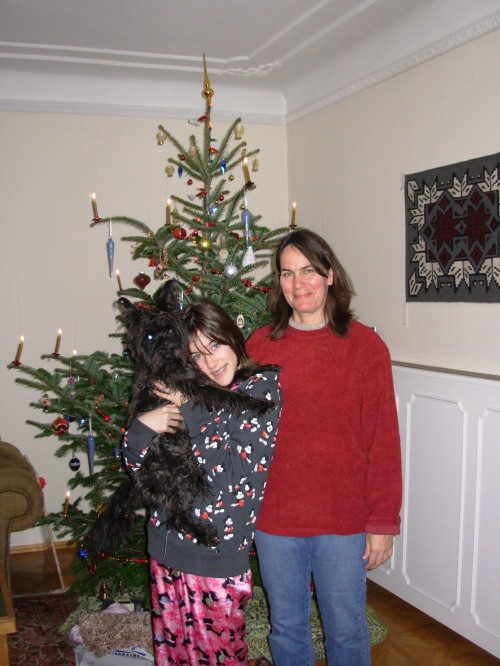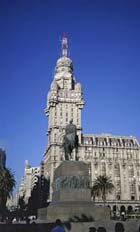Another Christmas come and gone. It hardly seems possible we have been here six months already. Thanks to everyone for all the well wishes and inquiries. We miss you all and hope this site will inspire a visit!

Karen, Jesse & Astro!
We would like to start by describing our recent activities and then perhaps digress a bit to catch you all up on the past six months, after which we will try to get back to some semblance of chronological order! We apologize in advance for those of you whom may have read or heard some of this already via e-mail or telephone.
Settlements along the Danube near what is now the City of Vienna can be traced back to the 5th century B.C. These were of Celtic origin – as is the name Wien, derived from the Celtic “Vedunia” meaning “river in the woods”. The Romans established the garrison camp Vindobona in the 1st century AD. Remainders of the Roman camp can be seen at Hoher Markt and at the underground station Stephansplatz. Vienna began its rise in importance in the Middle Ages when it was made the residence of the Babenbergs and the city walls were raised in 1200. Vienna would become the capital of the Habsburg Empire and remain so for almost seven centuries. Today its imperial past is still visible in monumental structures such as the Imperial Palace (Hofburg), the Schönbrunn Palace, the buildings along Ringstraße, and many other sites throughout the city.
The fall of the monarchy proved a turning point in Vienna’s history. In 1922, the city was made a province in its own right. The Social Democrats then in power pursued comprehensive social policies. By 1933 more than 60,000 new and affordable apartments had been built. The achievements of the “rotes Wien” (Red Vienna) in the social field found international recognition.
In 1938 Austria was “annexed” to Hitler Germany and ceased to exist as a state. Most of Vienna’s Jewish population was driven away or exterminated. After the end of the Second World War and many years of Allied occupation, Austria regained its independence with the state treaty signed in 1955. Unperturbed by the nearby existing Iron Curtain, Vienna continued to build on its international role during the Cold War years. It became a UN seat
However, we don’t exactly live in Vienna (Wien), we actually live in Langenzersdorf a 900 year old village about 8km north of Vienna along the banks of the Danube (Donau) River and next to a hilly area called the Bisamberg. It is a wonderful little place in the heart of wine country ( Yeah!) with many little heurigens (wine taverns) in and on the surrounding hillsides (see photo). Nationalities around the table are US, N.Korea, German (one of Finnish extract), S. African and British. So cool.

Langer Huerigen atop the Bisamberg
We rented our home from a lovely little Austrian couple, the Kleinraths, whose graciousness we shall never forget. The home has a beautiful garden (yard to most of you) and a Wein keller (wine cellar..actually two !) It is approximately 100 years old with flower boxes, fruit and nut trees and a beautiful patio.(More on this later)…on with the story.
December has been a busy month for us. Vienna is beautiful especially at Christmas. The city is decorated handsomely and there are small Christmas markets scattered throughout. They sell handmade ornaments and gluwein (a spicy warm wine drink to ward off the cold). People bundle up and go out in the evenings to these brightly lit markets, which consist of many small booths of vendors. The decorations are gorgeous, ranging from handblown glass figurines to straw snow flakes and everything in between. Its a very festive environment with the aroma of roasting chestnuts, colored lights and the gleeful sounds of the children in anticipation of Christmas. We did our share for the local ecomomy as we left our decorations in storage in Albuquerque! We actually placed candles on our tree this year in addition to the usual electric lights..it was beautiful and gives new meaning to “lighting the tree”.

O Tannenbaum!
After having lived decades in the drought stricken dry southwestern forests of the US, it went against every grain in Russel’s body to deliberately set fire to his Christmas tree inside the house (more on the house later too). However all went well, the tree and the house are still intact.
The week before Christmas we went skiing with our friends, the Kinker’s (more about them later), Katarina and Megala( a german teacher at Jesse’s school and her daughter) in the Austrian Alps at a place called Obertauren.

Obertauren
Its south of Salzburg near a village called Radstadt (about 3.5 hour drive from Vienna). The place is huge, 26 lifts and over 100 kilometers of trails! They advertize a conveying capacity of over 47,000 people per hour. However we never stood in line more than 1-2 minutes the entire 4 days. It includes seven peaks, the highest, Gurpitsch Eck , is at 2526m elevation. There are cross country ski areas, lighted areas for night skiing, toboggan runs, timed runs and a fun park loaded with jumps and half-pipes etc. The snow was plentiful,wet and heavy.

Jesse,Beatta,Megela
The ski area was a series of gigantic basins (surrounded by the seven peaks). The weather ranged from partly cloudy to heavy snow and fog. Russel, Karen, John and Monika (the Kinkers) skied. While Jesse, Beatta*, Erik* (* kinker children) and Megala snow boarded..skiing is for old folks you know! The photo of Obertauren shown above is at the top of the Grunwaldkopfbahn lift (easy for you to say!) featuring the Hochalm resturant and Seekarspitz Peak (2350m) in the distance.
Paraguay
Changing hemispheres now, Russel travelled to South America earlier in the month to Montevideo, Uruguay and to Asuncion, Paraguay for work. The mission was to discuss the status of the uranium resource development in each country. It was summer and the people were wonderful. Both places are large cattle producers and some aspects reminded Russel of his Oklahoma roots!

A Rancher in Paraguay
Asuncion (Nuestra Senora de Santa Maria de Asuncion) was founded by Spaniards, led by Juan de Salazar y Espinoza in 1537.

The White House in Asuncion
The Jesuit Missions of La Santisima Trinidad de Parana and the Jesus de Tavarangue Mission are on the World Heritage List.
Paraguay gained independence in 1811.
The War of the Triple Alliance between Paraguay and [the alliance of] Argentina, Uruguay and Brazil (1865-1870) resulted in the loss of large areas of land as well as the lives of a very high percentage of Paraguay’s soliders.
The Chaco War (1932-1935) between Paraguay and Bolivia was an attempt by landlocked Bolivia to gain access to the Atlantic coast through the Rio de la Plata river system.
The first railway line in Paraguay, constructed between 1858 and 1861, was built by British engineers. Remnants are still visible today.
The Itaipu hydroelectric power plant, a joint project between Paraguay and Brazil (1975-1991), supplies substantial amounts of energy to both countries. Russel was told that 25% of the electricity produced at Itaipu powers nearly the entire country of Paraguay, and the remaining 75% provides Brazil with approximately one fifth of its electrical power.
Uruguay
All of South America, and this land called Uruguay, was occupied by large groups of indigenous Indian peoples long before the Europeans arrived.
When the Spanish Explorer, Juan Diaz de Solis, came ashore in the area in 1516, his welcoming was rather unfriendly, as Solis, and most of his landing party were promptly killed by Indians.
In 1680, the Portuguese founded Colonia on the edge of the River Plate, directly across from the Spanish controlled city of Buenos Aires.
 In response, the Spanish established Montevideo as a military stronghold, and with its natural harbor, this upstart settlement soon became an important regional center of commerce.
In response, the Spanish established Montevideo as a military stronghold, and with its natural harbor, this upstart settlement soon became an important regional center of commerce.

Montevideo Today
At the beginning of the 19th century, after many decades of forced Spanish control, Jose Gervasio Artigas, an exiled military officer, led the long struggle for political freedom, and that independence came to fruition in 1825; and then, in 1828, the State of Uruguay was officially created.
Uruguay’s independence was immediately threatened, as both Argentina and Brazil desired this land. Subsequently, it wasn’t long before Montevideo was overrun, and warring factions immersed this new country into civil war and political dictatorships.
A somewhat short-lived productive era began in the early 20th century, as governmental reforms included a long list of social services, including free health care and education, pensions for workers, and a real concentrated effort to improve the economy. 
In short-order this proved problematic, as Uruguay, with few natural resources, soon experienced financial pressures on its new welfare state that grew to unmanageable levels; this brought political unrest, another dictatorship, and then, a disastrous guerrilla movement, one that took Uruguay’s military many years to finally control. Civilian rule was finally restored in 1985, and in 2004, a new and progressive coalition won national elections, which in essence ended 175 years of political instability in the country.